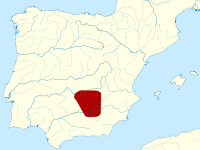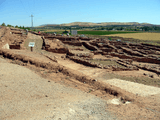Oretani
The Oretani or Oretanii (Greek: Orissioi)[1] were a pre-Roman ancient Iberian people (in the geographical sense) of the Iberian Peninsula (the Roman Hispania), that lived in today's northeastern Andalusia, in the high Baetis (Guadalquivir) river valley, eastern Marianus Mons (Sierra Morena), and the southern area of today's La Mancha.
They could have been an Iberian tribe, a Celtic one, or a mixed Celtic and Iberian tribe or tribal confederacy (and hence related to the Celtiberians).
The Mantesani/Mentesani/Mantasani of today's La Mancha and the Germani (of Oretania) in eastern Marianus Mons (Sierra Morena) and west Jabalón river valley sometimes are included in the Oretani but it is not certain if they were Oretani tribes.

Location

Oretania, the country of the Oretani, was located in the eastern Sierra Morena, which included most of Ciudad Real Province except its western end, the northern section of Jaén Province, the western half of Albacete Province and the southern rim of Cuenca Province. The Roman geographer Pliny the Elder lists 14 cities, including Tuia/Tugia (Toya?), Salaria (Úbeda/Baeza?), Biatia, Castulum (Cazlona, Jaén),[2] Luparia, Cervaria and Salica,[3] whilst Diodorus Siculus lists 12 towns.[4] Other sources refer the towns of Libissosa (Lezuza?),[5] Amtorgis, Ilorci, Helicen/Helike (Elche de la Sierra, Elche?),[6] Baecula/Bekor (Bailén, Jaén),[7][8] Ilucia, Nobila and Cusibi.[9]
Culture


They are believed by some to have spoken an Iberian language, by others to have been Celtic language, akin to the Celtiberians, as the northern Oretani were also called Germani and Mantesani. The main archaeological sites in the oretanian area are Linares, La Carolina, Montiel, Valdepeñas, Almagro, Oreto and Zuqueca, and Cerro de las Cabezas.
History
The Oretani remained independent until the late 3rd Century BC, when their powerful King Orison was defeated at the Battle of Helicen in 228 BC.[10] Orison’s defeat in 227 BC[11] and the subsequent alliance with Carthage, however, caused major friction with their Germani allies who continued to resist Punic expansion until being subdued by Hannibal in 221 BC; the latter were certainly amongst the Oretani troops sent to Africa at the outbreak of the Second Punic War.
Romanization
Like the Germani, the Oretani appear to have adopted a less hostile stance towards Rome and in 156 BC both peoples were included into Hispania Citerior Province, though retaining their Iberian cultural identity for several more centuries.
See also
Notes
- ↑ Rosario Garcia Huelva & Francisco Javier Morales Hervás, Los Oretanos in Prehistoria y Protohistoria de la Meseta Sur (Castilla-La Mancha) (2007), p. 217.
- ↑ Strabo, Geographikon III, 3, 2.
- ↑ Pliny the Elder, Naturalis Historia III, 19.
- ↑ Diodorus Siculus, Bibliotheca historica 25, 42.
- ↑ Rosario Garcia Huelva & Francisco Javier Morales Hervás, Los Oretanos in Prehistoria y Protohistoria de la Meseta Sur (Castilla-La Mancha) (2007), p. 218.
- ↑ Appian, Iberiké 6; 65.
- ↑ Polybius, Istorion 10, 38, 7; 11, 20.
- ↑ Livy, Ab Urbe Condita 27: 18; 28: 13.
- ↑ Livy, Ab Urbe Condita 35: 7, 6; 22: 5.
- ↑ Appian, Iberiké 6.
- ↑ Diodorus Siculus, Bibliotheca historica 25, 42.
References
- Ángel Montenegro et alii, Historia de España 2 - colonizaciones y formación de los pueblos prerromanos (1200-218 a.C), Editorial Gredos, Madrid (1989) ISBN 84-249-1386-8
- Francisco Burillo Motoza, Los Celtíberos – Etnias y Estados, Crítica, Grijalbo Mondadori, S.A., Barcelona (1998, revised edition 2007) ISBN 84-7423-891-9
- Juan Pereira Siesto (coord.), Prehistoria y Protohistoria de la Meseta Sur (Castilla-La Mancha), Biblioteca Añil n.º 31, ALMUD, Ediciones de Castilla-La Mancha, Ciudad Real (2007) ISBN 84-934858-5-3
External links
| Wikimedia Commons has media related to Oretani. |